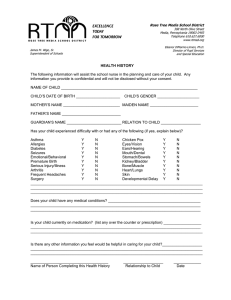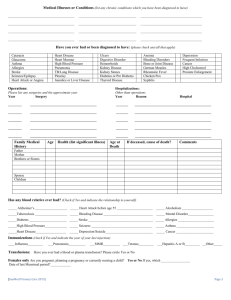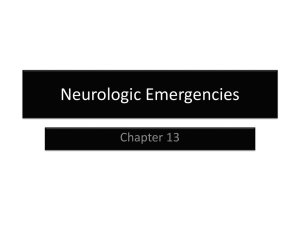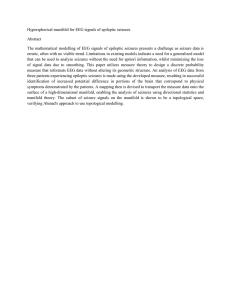Chapter 19 Neurology 19-1
advertisement
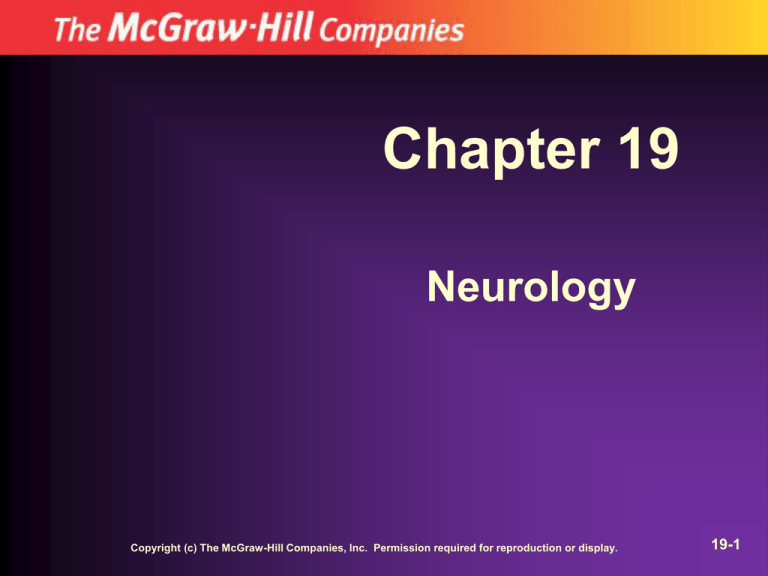
Chapter 19 Neurology Copyright (c) The McGraw-Hill Companies, Inc. Permission required for reproduction or display. 19-1 Objectives 19-2 Altered Mental Status 19-3 Altered Mental Status • Change in a patient’s level of awareness • Also called an altered level of consciousness (ALOC) 19-4 Common Causes of Altered Mental Status • • • • • Alcohol, Abuse Epilepsy Insulin Overdose Uremia • Trauma, Temperature • Infection • Psychiatric conditions • Poisoning • Shock, Stroke 19-5 Emergency Care • Care focuses on airway, breathing, circulation • Stabilize spine if trauma is suspected • Give oxygen • Undo tight clothing • Assess vital signs, oxygen saturation • Maintain body temperature • Comfort, calm, reassure patient 19-6 Seizures 19-7 Seizures • Temporary change in behavior or consciousness • Caused by abnormal electrical activity within 1 or more groups of brain cells • A symptom (not a disease) of an underlying problem in the central nervous system 19-8 Causes of Seizures • Unknown cause • Failure to take antiseizure medication • Rapid rise in body temperature • Infection • Hypoxia • Head trauma • Brain tumor • Poisoning • Hypoglycemia • Seizure disorder • Previous brain damage • Electrolyte disturbances • Alcohol or drug withdrawal • Eclampsia • Abnormal heart rhythm • Genetic/hereditary factors • Stroke 19-9 Types of Seizures • Generalized seizures – Tonic-clonic – Absence • Partial seizures – Simple partial – Complex partial 19-10 Generalized Seizures • Tonic-clonic seizures – Very common – Also called generalized motor seizures or grand mal seizures 19-11 Generalized Seizures • Tonic-clonic seizures – Usually has four phases: 1. 2. 3. 4. Aura Tonic phase Clonic phase Postictal phase 19-12 Generalized Seizures • Absence (petit mal) seizures – Usually occur in children older than 5 years of age – Can occur in adults – Brief loss of consciousness (for 5 to 10 seconds) without a loss of muscle tone 19-13 Simple Partial Seizures • Also called focal seizures or focal motor seizures • Usually last about 10 to 20 seconds • Involve motor or sensory symptoms with no change in mental status 19-14 Complex Partial Seizures • Also called a temporal lobe seizure or psychomotor seizure • Patient’s consciousness, responsiveness, or memory is impaired • Often preceded by an aura • Generally lasts less than 30 minutes • May be associated with repeat behaviors (automatisms) 19-15 Status Epilepticus • Recurring seizures without an intervening period of consciousness • Medical emergency • Can cause brain damage or death if it is not treated 19-16 Patient Assessment • Scene size-up • Primary survey • Secondary survey/physical exam – Check for medical identification device – Possible poisoning or toxic exposure? – Signs of recent trauma? • Show a caring attitude 19-17 Patient Assessment History • First seizure? • History of seizures? – Seizure medication? – How often do the seizures usually occur? – Does this seizure look like those the patient has had before? • Does the patient have a history of stroke or diabetes? • Does he have a history of heart disease? • Does the patient use or abuse alcohol or drugs? 19-18 Patient Assessment History • What was the patient doing at the time of the seizure? – Did he hit his head or fall? • Did the patient cry out or attract your attention in any way? • What did the seizure look like? When did the seizure start? How long did it last? • Did the seizure begin in 1 area of the body and progress to others? • Did the patient lose bowel or bladder control? 19-19 Patient Assessment History • When the patient woke up, was there any change in his speech? • Was he able to move his arms and legs normally? • Did the patient exhibit any unusual behavior before, during, or after the seizure? 19-20 Emergency Care • Treatment can be difficult – Patient may be combative or confused • Normal in the postictal phase – Focus on the ABCs 19-21 Emergency Care • Protect the patient’s privacy • Position the patient • Protect the patient from harm • Do not insert anything into the patient’s mouth • Loosen tight clothing • Remove eyeglasses • Do not try to restrain body movements [Insert figure 19-3] 19-22 Emergency Care • • • • Make sure the patient’s airway is open Suction if necessary Give oxygen Comfort, calm, and reassure the patient and family • Watch closely for repeat seizures • Relay patient information to appropriate healthcare personnel • Minimize patient exposure to bright lights and loud noises 19-23 Stroke 19-24 Stroke • Caused by the blockage or rupture of an artery supplying the brain • Also called a cerebrovascular accident or brain attack 19-25 Types of Stroke • Ischemic stroke – Thrombotic – Embolic • Hemorrhagic stroke – Subarachnoid hemorrhage – Intracerebral hemorrhage 19-26 Ischemic Stroke • Caused by a blood clot that decreases blood flow to the brain • 80% of all strokes are ischemic strokes • Types of ischemic strokes [Insert figure 19-5] – Thrombotic – Embolic 19-27 Hemorrhagic Stroke • Caused by bleeding into the brain • Accounts for remaining 20% of all strokes • Two forms – Subarachnoid hemorrhage – Intracerebral hemorrhage 19-28 Transient Ischemic Attack (TIA) • “Mini-stroke” • Temporary interruption of the blood supply to the brain • Signs and symptoms – Resemble those of a stroke but are temporary – Last from a few minutes to several hours 19-29 Stroke Risk Factors • • • • • Hypertension Cigarette smoking Cardiovascular diseases Diabetes mellitus TIA 19-30 Stroke Warning Signs • Sudden weakness or numbness of the face, arm, or leg on one side of the body • Sudden facial drooping, inability to swallow, or tongue deviation • Sudden dimness or loss of vision, particularly in one eye • Loss of speech; trouble talking or understanding speech • Sudden, severe headache with no known cause • Unexplained dizziness, unsteadiness, or sudden falls • Confusion, agitation, combativeness, coma • Seizures • Inappropriate behavior, such as excessive laughing or crying 19-31 Stroke Assessment Tools • FAST assessment – Face – Arms – Speech – Time 19-32 Stroke Assessment Tools • Give Me 5 for Stroke 1. Walk: Is their balance off? 2. Talk: Is their speech slurred or face droopy? 3. Reach: Is one side weak or numb? 4. See: Is their vision all or partly lost? 5. Feel: Is their headache severe? 19-33 Stroke Assessment Tools • Cincinnati Prehospital Stroke Scale 1.Facial droop 2.Arm drift 3.Speech 19-34 History • Find out: – Trauma to the head or neck? – Taking any medications? – When did patient’s symptoms begin? – Sudden or gradual onset? – Any seizure activity? – Pertinent past medical history 19-35 Emergency Care • • • • • • • Spinal stabilization if trauma is suspected Establish and maintain an open airway Give oxygen Position the patient and do not allow to walk Protect paralyzed extremities from injury Explain procedures to the patient Assess vital signs, oxygen saturation, blood glucose level • Do not allow to eat or drink • If appropriate, transport to nearest Stroke Center 19-36 Syncope 19-37 Syncope • A brief loss of responsiveness caused by a temporary decrease in blood flow to the brain • Fainting • Blackout 19-38 Syncope Common Causes • • • • • • • • • Low blood sugar Bearing down Strenuous coughing Breath holding or hyperventilation Sight of blood Standing in place too long Bleeding, dehydration Some drugs Sudden drop in BP • Standing up suddenly • Head trauma • Hot and humid conditions • Crowded places • Eating a heavy meal • Fasting • Heart rate too fast/too slow • Stroke • Witness to violence 19-39 Near Syncope • • • • • • Dizziness Anxiety Lightheadedness Pale skin Sweating Weakness • • • • Nausea Thready pulse Low blood pressure Partial or complete loss of vision or hearing 19-40 Patient Assessment • Spinal stabilization if any possibility of trauma • Assess mental status, airway, breathing, and circulation • Focused history and physical examination if responsive • Rapid medical assessment if unresponsive 19-41 Emergency Care • Establish and maintain an open airway – Stabilize cervical spine if possibility of trauma • • • • Give oxygen Position the patient supine Remove or loosen tight clothing Assess vital signs, oxygen saturation, blood glucose level • Maintain body temperature • Comfort, calm, and reassure patient and family • Reassess 19-42 Headache 19-43 Sinus Headaches • Sinuses – Produce mucus and trap bacteria – Become swollen and inflamed if passages are blocked – Infection can result when bacteria become entrapped in the sinus tissues • Headaches can be triggered by the resulting pressure changes in the sinuses. 19-44 Tension-type Headaches • Most common type of headache • Can occur at any age – Onset during adolescence or young adulthood is common • Mild to moderate pain • Feels like a tight band around the head • Exact cause is unknown 19-45 Migraine Headaches • Thought to be caused by changes in a major pain pathway and imbalances in brain chemicals • May be accompanied by nausea, vomiting, abdominal pain, or sensitivity to light • Can occur with or without an aura • Family history of migraines common 19-46 Cluster Headaches • Attacks of severe pain primarily localized to the eye, temple, forehead, or cheek – Attacks occur in cyclical patterns (clusters) • Cause is uncertain • Typically begins quickly, usually without warning 19-47 Medication-induced Headaches • Also called rebound headaches • Can result from overuse of medications or substances 19-48 Organic Headaches • Organic headaches are the result of an abnormality in the brain or skull. • Possible causes – Infection – Cerebral hemorrhage – Benign or malignant brain tumor – Cerebral aneurysm 19-49 Patient Assessment • Spinal stabilization if any possibility of trauma • Assess mental status, airway, breathing, and circulation • Focused history and physical examination if responsive • Rapid medical assessment if unresponsive 19-50 Possible Signs/Symptoms • Sinus headaches – Dull pressure-like pain in one specific area of the face or head, such as behind the eyes – Facial tenderness to touch – Pain may worsen with sudden movement of the head or bending forward – Yellow-green or blood-tinged nasal discharge – Possible fever 19-51 Possible Signs/Symptoms • Mild to moderate pain that feels like a tight band around the head • Headache occurs primarily in the forehead, temples, back of the head and/or neck • Tightness in the neck, as if the head and neck were in a cast 19-52 Possible Signs/Symptoms • Cluster headaches – Sudden onset of excruciating pain described as sharp, penetrating, boring, or burning; pain is so intense that most patients cannot sit still – Tearing of the eye, swelling around the eye, possible drooping eyelid, and a stuffy or runny nose on the affected side of the face – Flushing on the affected side of the face – Sweaty, pale skin 19-53 Possible Signs/Symptoms • Medication-induced headaches – Typically occur daily – Start of the headache is generally the worst, as the medication wears off – Nausea – Anxiety, restlessness, irritability, difficulty concentrating – Depression – Trouble sleeping 19-54 Possible Signs/Symptoms • Organic headaches – Sudden sharp, intense, or severe headache – Sudden lack of balance or falling – Confusion – Inappropriate behavior – Seizures – Difficulty speaking 19-55 Emergency Care • Establish and maintain an open airway – Stabilize cervical spine if possibility of trauma • Give oxygen • Position of comfort • Assess vital signs, oxygen saturation, blood glucose level • Comfort, calm, and reassure patient and family 19-56 Questions? 19-57

